Unit 6 An old man tried to move the mountains. Section A (3a~3c) 课件(共21张PPT,内嵌音视频) 2024-2025学年英语人教版
文档属性
| 名称 | Unit 6 An old man tried to move the mountains. Section A (3a~3c) 课件(共21张PPT,内嵌音视频) 2024-2025学年英语人教版 | 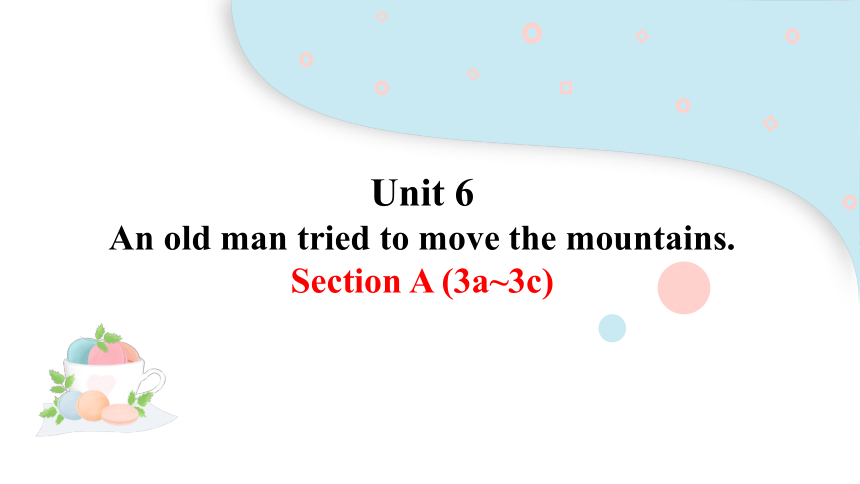 | |
| 格式 | pptx | ||
| 文件大小 | 27.8MB | ||
| 资源类型 | 教案 | ||
| 版本资源 | 人教新目标(Go for it)版 | ||
| 科目 | 英语 | ||
| 更新时间 | 2024-12-13 15:24:14 | ||
图片预览

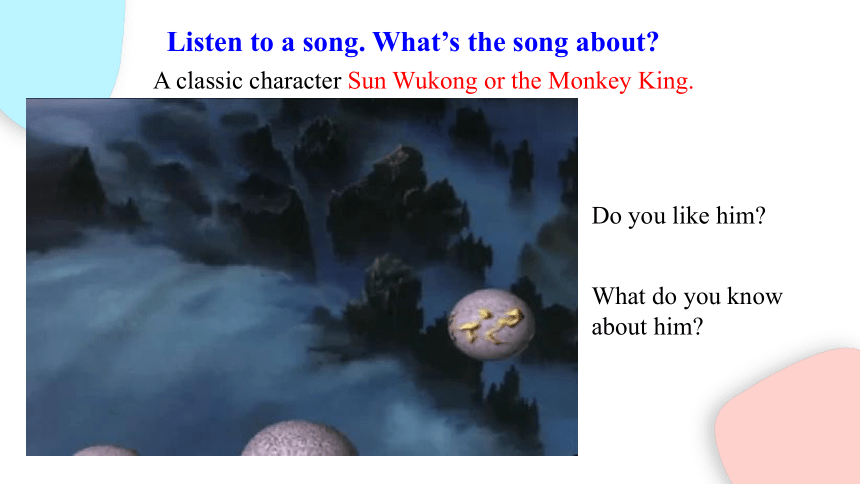
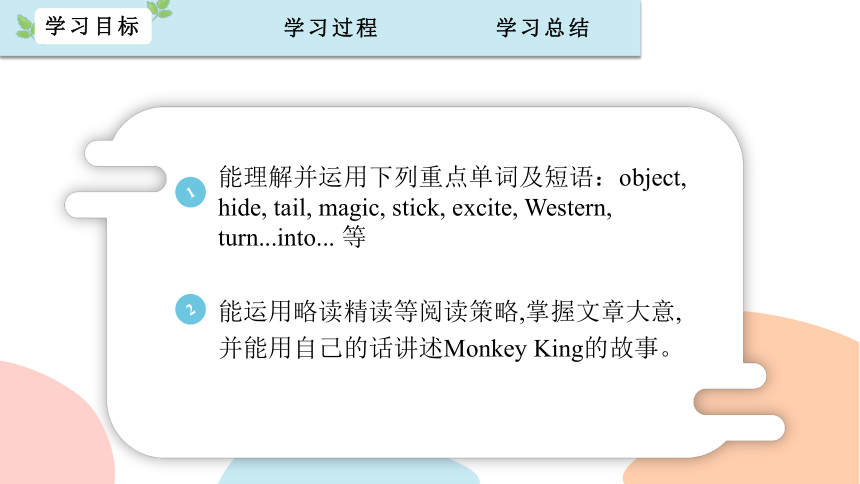
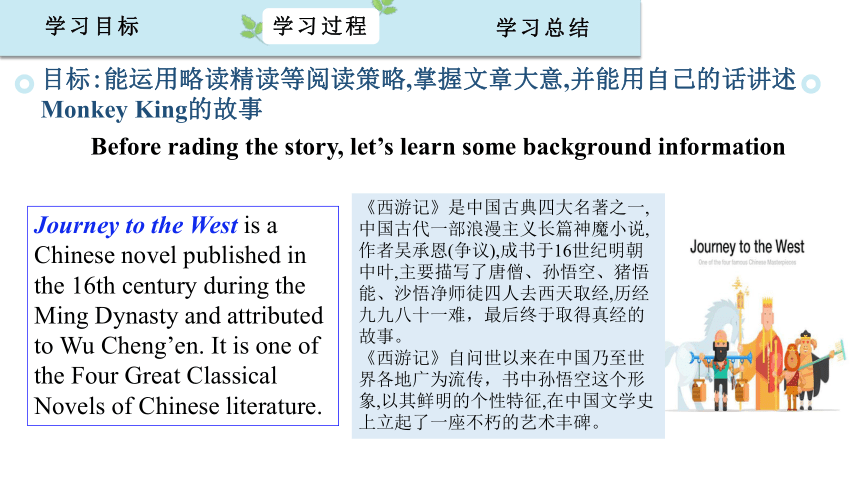
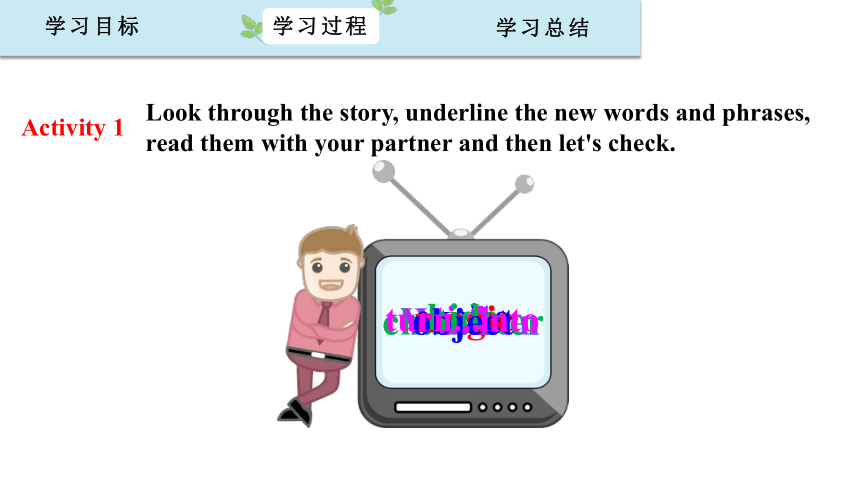
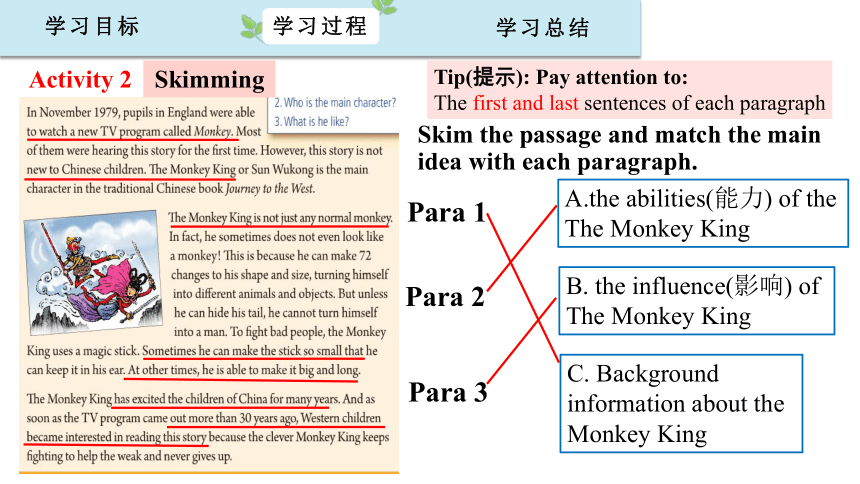
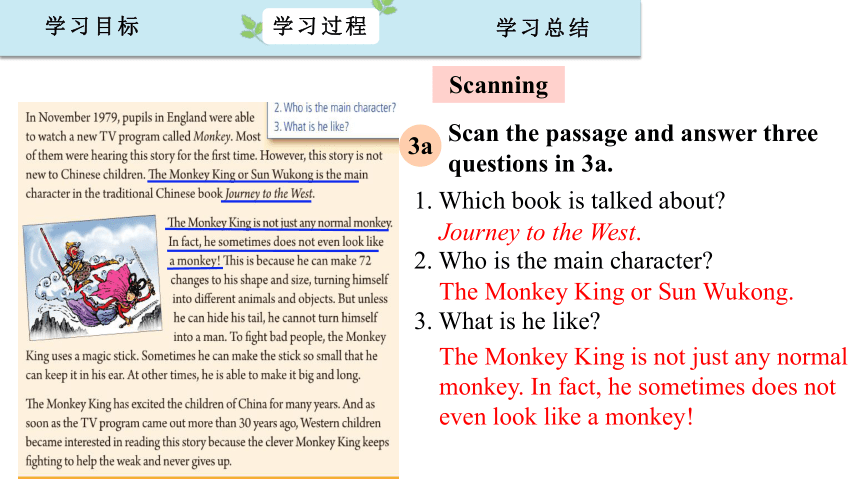
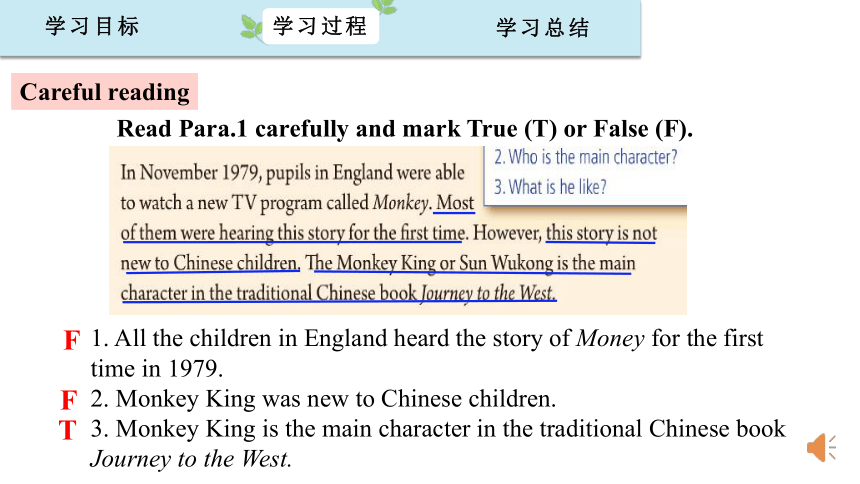
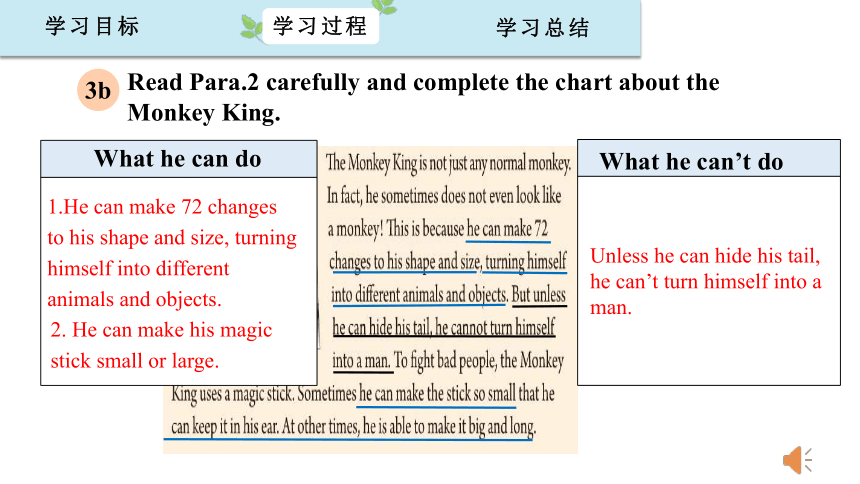
文档简介
(共21张PPT)
Unit 6
An old man tried to move the mountains.
Section A (3a~3c)
Listen to a song. What’s the song about
A classic character Sun Wukong or the Monkey King.
Do you like him
What do you know
about him
能理解并运用下列重点单词及短语:object, hide, tail, magic, stick, excite, Western,
turn...into... 等
1
2
能运用略读精读等阅读策略,掌握文章大意,并能用自己的话讲述Monkey King的故事。
目标:能运用略读精读等阅读策略,掌握文章大意,并能用自己的话讲述Monkey King的故事
Before rading the story, let’s learn some background information
Journey to the West is a Chinese novel published in the 16th century during the Ming Dynasty and attributed to Wu Cheng’en. It is one of the Four Great Classical Novels of Chinese literature.
《西游记》是中国古典四大名著之一,中国古代一部浪漫主义长篇神魔小说,作者吴承恩(争议),成书于16世纪明朝中叶,主要描写了唐僧、孙悟空、猪悟能、沙悟净师徒四人去西天取经,历经九九八十一难,最后终于取得真经的故事。
《西游记》自问世以来在中国乃至世界各地广为流传,书中孙悟空这个形象,以其鲜明的个性特征,在中国文学史上立起了一座不朽的艺术丰碑。
Look through the story, underline the new words and phrases,
read them with your partner and then let's check.
Activity 1
character
Western
excite
stick
magic
tail
hide
object
turn...into
Skim the passage and match the main idea with each paragraph.
Para 1
Para 2
Para 3
the abilities(能力) of the
The Monkey King
B. the influence(影响) of
The Monkey King
C. Background
information about the
Monkey King
Activity 2
Skimming
Tip(提示): Pay attention to:
The first and last sentences of each paragraph
3a
1. Which book is talked about
2. Who is the main character
3. What is he like
Scan the passage and answer three questions in 3a.
Journey to the West.
The Monkey King or Sun Wukong.
The Monkey King is not just any normal
monkey. In fact, he sometimes does not
even look like a monkey!
Scanning
Careful reading
Read Para.1 carefully and mark True (T) or False (F).
1. All the children in England heard the story of Money for the first time in 1979.
2. Monkey King was new to Chinese children.
3. Monkey King is the main character in the traditional Chinese book Journey to the West.
F
F
T
3b
Read Para.2 carefully and complete the chart about the Monkey King.
What he can’t do
What he can do
1.He can make 72 changes
to his shape and size, turning
himself into different
animals and objects.
2. He can make his magic
stick small or large.
Unless he can hide his tail, he can’t turn himself into a man.
Read Para.3 carefully and finish the questions.
1. The time when Western children became interested in the Monkey King:___________________________________.
2. Why are children interested in reading the story about the Monkey King __________________________________________________
__________________________________________________
as soon as it came out over 30 years ago
Because the clever Monkey King keeps fighting to help the
weak and never give up.
Activity 3
Work in groups. Find out some language points that you think are important and share their use with your classmates and give some examples.
Language point
1. In November 1979, pupils in England were able to watch a TV program called Monkey.
1) be able to 能够,有能力。相当于情态动词can。后跟动词的原形。
e.g. I can clean up the living room. Are you able to do the dishes
我可以打扫卧室,你能洗碗吗?
2) called 叫做,命名。相当于named,在文中作TV program的后置定语。
e.g. I don't know which is the boy called / named Tom.
我不知道哪个男孩叫汤姆。
most 与 most of 的区别
(1) 若所修饰的名词前没有限定词,通常要用 most
(2) 在习惯上不带冠词的专有名词(如人名和地名等)或抽象名词
(如学科名词等)前,用most of
(3) 若所修饰的名词前带有限定词,则用most of,不能只用most
(4) 若直接用在代词之前,用most of
e.g. Most people agree with me. 多数人同意我的意见。
Most of the people here know each other. 这里大多数人互相认识。
2. Most of them were hearing this story for the first time.
他们大部分人都是第一次听说这个故事
Language point
Language point
3.The clever Monkey King keeps fighting to help the weak and never gives up.
keep doing sth. 一直持续做某事
keep on doing sth. 一直反复做某事
e.g. She kept running. 她一直在跑(没停过)。
She kept on raising her hand. 她反复举手(不是一直举着手)。
4. Sometimes he can make the stick so small that he can keep it in his ear.
stick作为名词,意为“棍;条;拐棍” 。
e.g. He used a stick to beat the dog. 他用一根棍子打狗。
stick还可以作动词,表示“刺;插入;粘贴” 等意思。过去式、过去分词均为stuck。
e.g. He stuck a nail in the wall. 他往墙上插入了一根钉子。
Language point
Language point
【拓展】辨析stick与glue
stick 指用胶水粘贴,可引申为“坚持”。stick to sth.坚持某事;stick with sb.继续支持某人。
glue 与stick的本义相同,指用胶水把东西粘合在一起,没有“坚持”的含义。
5. The Monkey King has excited the children of China for many years.
excite: 动词;使兴奋;使激动。多用物做主语。
excited:形容词;兴奋的;激动的。用来修饰人物。
exciting:形容词;令人兴奋的。用来修饰事物。
e.g. The story is very exciting. It excites a lot of students to read it. We are excited about it, too.
这个故事非常令人兴奋,它激发了许多学生去阅读它,我们也为此感到兴奋。
Language point
6. As soon as the TV program came out more than 30 years ago, Western children became interested in reading this story.
As soon as 意为:一……就…… ,引导时间状语从句。当主句是一般过去时的时候,从句也用一般过去时;当主句是一般将来时的时候,从句用一般现在时表示将来,即主将从现。
e.g. As soon as Tom saw (see) the cat, he fell in love with it.
汤姆一看见那只猫,就爱上了它。
Language point
3c
Complete the sentences below with phrases from the passage.
1.Journey to the West is a __________ Chinese book. It tells one of
the most popular stories in China.
2. When the English TV program Monkey _________ in 1979,
Western children __________________ this wonderful story.
3. The Monkey King can _____________ to his body. He is able to
________ different animals and objects.
4. The Monkey King _________ make his magic stick small or large.
traditional
came out
became interested in
make changes
turn into
is able to
Activity 4
Activity 5
What do you think of Monkey King
clever
funny
brave
responsible
…
never give up fighting
to help the weak.
have a sense of justice
try our best to help others
…
Retelling time
Try to retell the passage according to mind map.
Introduction
Background
information
Abilities
Influnence
/Reason
…is the main character in the book ….
He can make ….
He uses a …to …bad people.
He can make his stick …or ….
But he cannot turn …into …unless …
…has excited Chinese children …
…Western children became interested in …
Because he keeps fighting to…and never …
Unit 6
An old man tried to move the mountains.
Section A (3a~3c)
Listen to a song. What’s the song about
A classic character Sun Wukong or the Monkey King.
Do you like him
What do you know
about him
能理解并运用下列重点单词及短语:object, hide, tail, magic, stick, excite, Western,
turn...into... 等
1
2
能运用略读精读等阅读策略,掌握文章大意,并能用自己的话讲述Monkey King的故事。
目标:能运用略读精读等阅读策略,掌握文章大意,并能用自己的话讲述Monkey King的故事
Before rading the story, let’s learn some background information
Journey to the West is a Chinese novel published in the 16th century during the Ming Dynasty and attributed to Wu Cheng’en. It is one of the Four Great Classical Novels of Chinese literature.
《西游记》是中国古典四大名著之一,中国古代一部浪漫主义长篇神魔小说,作者吴承恩(争议),成书于16世纪明朝中叶,主要描写了唐僧、孙悟空、猪悟能、沙悟净师徒四人去西天取经,历经九九八十一难,最后终于取得真经的故事。
《西游记》自问世以来在中国乃至世界各地广为流传,书中孙悟空这个形象,以其鲜明的个性特征,在中国文学史上立起了一座不朽的艺术丰碑。
Look through the story, underline the new words and phrases,
read them with your partner and then let's check.
Activity 1
character
Western
excite
stick
magic
tail
hide
object
turn...into
Skim the passage and match the main idea with each paragraph.
Para 1
Para 2
Para 3
the abilities(能力) of the
The Monkey King
B. the influence(影响) of
The Monkey King
C. Background
information about the
Monkey King
Activity 2
Skimming
Tip(提示): Pay attention to:
The first and last sentences of each paragraph
3a
1. Which book is talked about
2. Who is the main character
3. What is he like
Scan the passage and answer three questions in 3a.
Journey to the West.
The Monkey King or Sun Wukong.
The Monkey King is not just any normal
monkey. In fact, he sometimes does not
even look like a monkey!
Scanning
Careful reading
Read Para.1 carefully and mark True (T) or False (F).
1. All the children in England heard the story of Money for the first time in 1979.
2. Monkey King was new to Chinese children.
3. Monkey King is the main character in the traditional Chinese book Journey to the West.
F
F
T
3b
Read Para.2 carefully and complete the chart about the Monkey King.
What he can’t do
What he can do
1.He can make 72 changes
to his shape and size, turning
himself into different
animals and objects.
2. He can make his magic
stick small or large.
Unless he can hide his tail, he can’t turn himself into a man.
Read Para.3 carefully and finish the questions.
1. The time when Western children became interested in the Monkey King:___________________________________.
2. Why are children interested in reading the story about the Monkey King __________________________________________________
__________________________________________________
as soon as it came out over 30 years ago
Because the clever Monkey King keeps fighting to help the
weak and never give up.
Activity 3
Work in groups. Find out some language points that you think are important and share their use with your classmates and give some examples.
Language point
1. In November 1979, pupils in England were able to watch a TV program called Monkey.
1) be able to 能够,有能力。相当于情态动词can。后跟动词的原形。
e.g. I can clean up the living room. Are you able to do the dishes
我可以打扫卧室,你能洗碗吗?
2) called 叫做,命名。相当于named,在文中作TV program的后置定语。
e.g. I don't know which is the boy called / named Tom.
我不知道哪个男孩叫汤姆。
most 与 most of 的区别
(1) 若所修饰的名词前没有限定词,通常要用 most
(2) 在习惯上不带冠词的专有名词(如人名和地名等)或抽象名词
(如学科名词等)前,用most of
(3) 若所修饰的名词前带有限定词,则用most of,不能只用most
(4) 若直接用在代词之前,用most of
e.g. Most people agree with me. 多数人同意我的意见。
Most of the people here know each other. 这里大多数人互相认识。
2. Most of them were hearing this story for the first time.
他们大部分人都是第一次听说这个故事
Language point
Language point
3.The clever Monkey King keeps fighting to help the weak and never gives up.
keep doing sth. 一直持续做某事
keep on doing sth. 一直反复做某事
e.g. She kept running. 她一直在跑(没停过)。
She kept on raising her hand. 她反复举手(不是一直举着手)。
4. Sometimes he can make the stick so small that he can keep it in his ear.
stick作为名词,意为“棍;条;拐棍” 。
e.g. He used a stick to beat the dog. 他用一根棍子打狗。
stick还可以作动词,表示“刺;插入;粘贴” 等意思。过去式、过去分词均为stuck。
e.g. He stuck a nail in the wall. 他往墙上插入了一根钉子。
Language point
Language point
【拓展】辨析stick与glue
stick 指用胶水粘贴,可引申为“坚持”。stick to sth.坚持某事;stick with sb.继续支持某人。
glue 与stick的本义相同,指用胶水把东西粘合在一起,没有“坚持”的含义。
5. The Monkey King has excited the children of China for many years.
excite: 动词;使兴奋;使激动。多用物做主语。
excited:形容词;兴奋的;激动的。用来修饰人物。
exciting:形容词;令人兴奋的。用来修饰事物。
e.g. The story is very exciting. It excites a lot of students to read it. We are excited about it, too.
这个故事非常令人兴奋,它激发了许多学生去阅读它,我们也为此感到兴奋。
Language point
6. As soon as the TV program came out more than 30 years ago, Western children became interested in reading this story.
As soon as 意为:一……就…… ,引导时间状语从句。当主句是一般过去时的时候,从句也用一般过去时;当主句是一般将来时的时候,从句用一般现在时表示将来,即主将从现。
e.g. As soon as Tom saw (see) the cat, he fell in love with it.
汤姆一看见那只猫,就爱上了它。
Language point
3c
Complete the sentences below with phrases from the passage.
1.Journey to the West is a __________ Chinese book. It tells one of
the most popular stories in China.
2. When the English TV program Monkey _________ in 1979,
Western children __________________ this wonderful story.
3. The Monkey King can _____________ to his body. He is able to
________ different animals and objects.
4. The Monkey King _________ make his magic stick small or large.
traditional
came out
became interested in
make changes
turn into
is able to
Activity 4
Activity 5
What do you think of Monkey King
clever
funny
brave
responsible
…
never give up fighting
to help the weak.
have a sense of justice
try our best to help others
…
Retelling time
Try to retell the passage according to mind map.
Introduction
Background
information
Abilities
Influnence
/Reason
…is the main character in the book ….
He can make ….
He uses a …to …bad people.
He can make his stick …or ….
But he cannot turn …into …unless …
…has excited Chinese children …
…Western children became interested in …
Because he keeps fighting to…and never …
同课章节目录
- Unit 1 What's the matter?
- Section A
- Section B
- Unit 2 I'll help to clean up the city parks.
- Section A
- Section B
- Unit 3 Could you please clean your room?
- Section A
- Section B
- Unit 4 Why don't you talk to your parents?
- Section A
- Section B
- Unit 5 What were you doing when the rainstorm came
- Section A
- Section B
- Review of Units 1-5
- Unit 6 An old man tried to move the mountains.
- Section A
- Section B
- Unit 7 What's the highest mountain in the world?
- Section A
- Section B
- Unit 8 Have you read Treasure Island yet?
- Section A
- Section B
- Unit 9 Have you ever been to a museum?
- Section A
- Section B
- Unit 10 I've had this bike for three years.
- Section A
- Section B
